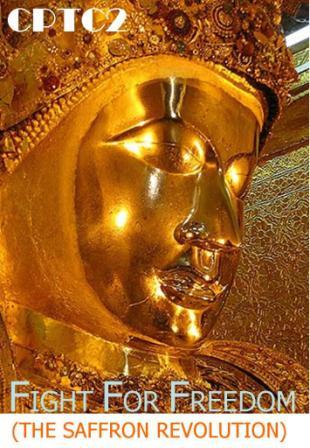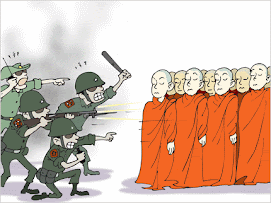Pagodas Have a Historic Place
By Shah Paung October 15, 2007
Burma’s pagodas have always served as a safe haven for Burmese people to gather. Until now, that is.
Soldier patrols at Rangoon's landmark Shwedagon Pagoda The troops who raided Rangoon’s most sacred monasteries, tramping through them in heavy boots, beating and arresting the monks, are now firmly in control. Pilgrims and other visitors are staying away, silence reigns.
Residents report that troops are stationed at Rangoon’s two most famous pagodas and rallying centers during the recent demonstrations, the Shwedagon Pagoda in Bahan Township, and Sule Pagoda, in the city center. There is also a strong troop presence at Kyaikkasan Pagoda in Thingangyun Township, where many monks were rounded up in the crackdown and several were reported to have died.
Local people say that about 15 military trucks packed with soldiers recently drove up to Kyaikkasan Pagoda and sealed it off, leaving only one entrance still open.
Residents said most of the troops stationed at the Sule Pagoda had been redeployed at the Kyaikkasan Pagoda. Troops had also been stationed at the Damayones religious hall, where pilgrims gather for Buddhist rites.
“The troops are taking over the pagodas,” a woman resident said, “It is as if they are guarding them like internment camps.”
Residents pointed out that even during the colonial era, political gatherings had been allowed at Rangoon’s Shwedagon Pagoda.
In 1920, university students gathered at a pavilion at the southwest corner of the Shwedagon Pagoda and planned the strike against the new University Act which grew into a mass protest movement. The strike resulted in the establishment of a national education system financed and run by the Burmese.
A second strike by university students in 1936 was centered at the Shwedagon Pagoda.
In 1938, striking workers from the oilfields of Chauk and Yenangyaung Townships, Magwe Division, set up camp at the Shwedagon Pagoda. The strike grew into what became known as the “1300 Revolution.”
Burma’s pagodas have always served as a safe haven for Burmese people to gather. Until now, that is.
Soldier patrols at Rangoon's landmark Shwedagon Pagoda The troops who raided Rangoon’s most sacred monasteries, tramping through them in heavy boots, beating and arresting the monks, are now firmly in control. Pilgrims and other visitors are staying away, silence reigns.
Residents report that troops are stationed at Rangoon’s two most famous pagodas and rallying centers during the recent demonstrations, the Shwedagon Pagoda in Bahan Township, and Sule Pagoda, in the city center. There is also a strong troop presence at Kyaikkasan Pagoda in Thingangyun Township, where many monks were rounded up in the crackdown and several were reported to have died.
Local people say that about 15 military trucks packed with soldiers recently drove up to Kyaikkasan Pagoda and sealed it off, leaving only one entrance still open.
Residents said most of the troops stationed at the Sule Pagoda had been redeployed at the Kyaikkasan Pagoda. Troops had also been stationed at the Damayones religious hall, where pilgrims gather for Buddhist rites.
“The troops are taking over the pagodas,” a woman resident said, “It is as if they are guarding them like internment camps.”
Residents pointed out that even during the colonial era, political gatherings had been allowed at Rangoon’s Shwedagon Pagoda.
In 1920, university students gathered at a pavilion at the southwest corner of the Shwedagon Pagoda and planned the strike against the new University Act which grew into a mass protest movement. The strike resulted in the establishment of a national education system financed and run by the Burmese.
A second strike by university students in 1936 was centered at the Shwedagon Pagoda.
In 1938, striking workers from the oilfields of Chauk and Yenangyaung Townships, Magwe Division, set up camp at the Shwedagon Pagoda. The strike grew into what became known as the “1300 Revolution.”






























No comments:
Post a Comment